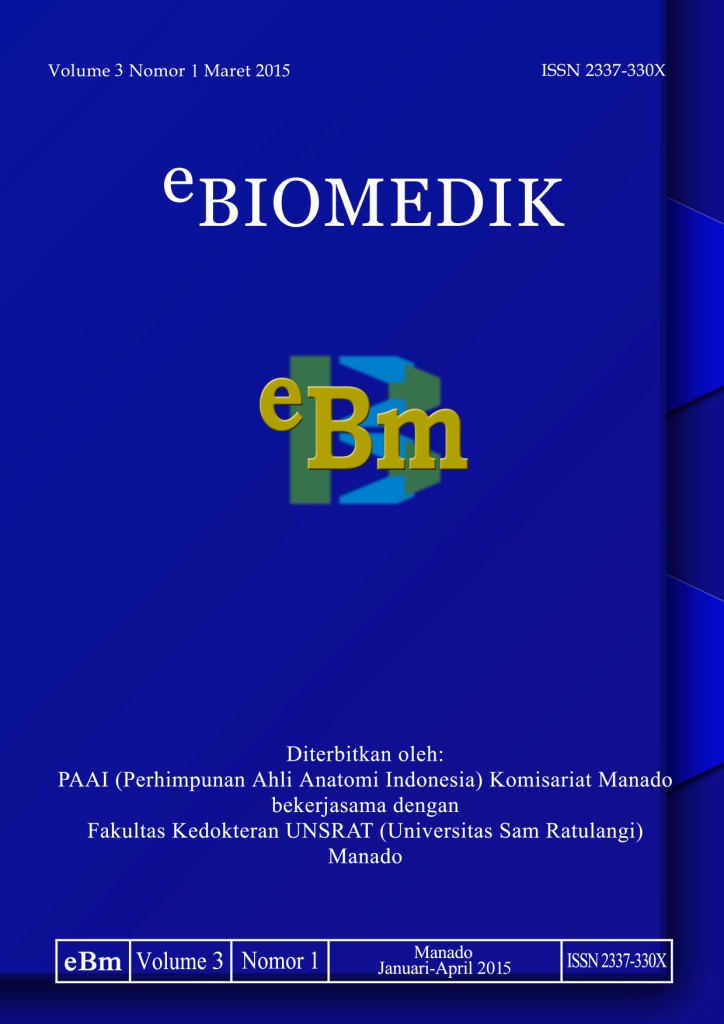PERBANDINGAN DETEKSI Blastocystis hominis DENGAN PEMERIKSAAN MIKROSKOPIS DAN PEMERIKSAAN COPRO ELISA
DOI:
https://doi.org/10.35790/ebm.v3i1.7476Abstract
Abstract: Blastocystis hominis is a frequent intestinal protozoa found in human digestive tract that causes Blastocystosis disease. The prevalence of B. hominis was reported in Indonesia about 60%. Blastocystis pose considerable challenges for diagnostic laboratories. Microscopic examination is a "gold standard" for detecting B. hominis but it is still difficult in some common laboratories, thus an alternative method is necessary. Another alternative examination to detect B. hominis is ELISA by detecting Blastocystis antigen in feces. This study aimed to compare the detection of Blastocystis hominis with microscopic examination and copro ELISA. This was an analytic diagnostic test. The population of this study was children who suffered from diarrhea. Samples were 33 stools of children suspected of having B. hominis. The results showed that from 33 samples through microscopic examination, positive results obtained 12 samples (36.4%) and 21 negative samples (63.6%). Meanwhile, through copro ELISA positive results obtained in 13 samples (39.4%) and 20 negative samples (60.6%). After diagnostic test, sensitivity values obtained 100%, specificity 95%, positive predictive value 92%, and negative predictive value of 100%. By using the Chi- square test with α 5% (0.05) then the microscopic value p = 0.117 > 0.05 and copro ELISA p = 0.223 > 0.05. It can be interpreted that there is no significant difference in the detection of Blastocystis hominis with microscopic examination and copro ELISA.
Keywords: blastocystis hominis, microscopic examination, copro ELISA.Abstrak: Blastocystis hominis merupakan salah satu protozoa usus yang sering ditemukan di saluran cerna manusia yang menyebabkan penyakit Blastocystosis. Prevalensi B. hominis dilaporkan di lndonesia sebesar 60%. Blastocystis menimbulkan tantangan yang cukup besar untuk diagnostik laboratorium. Pemeriksaan mikroskopis merupakan metode "standar emas" untuk mendeteksi B.hominis namun masih sulit dilakukan dibeberapa laboratorium umum sehingga diperlukan suatu metode diagnosis laboratorium alternatif. Pemeriksaan alternatif lain untuk mendeteksi B.hominis yaitu dengan pemeriksaan ELISA untuk mendeteksi antigen Blastocystis dalam tinja. Penelitian ini bertujuan untuk mengetahui perbandingan deteksi Blastocystis hominis dengan pemeriksaan mikroskopis dan pemeriksaan copro ELISA. Metode penelitian ini bersifat analitik dengan pendekatan uji diagnostik. Populasi penelitian ini ialah anak yang menderita diare, dan 33 tinja anak dicurigai menderita Blastocystis hominis sebagai sampel. Hasil penelitian menunjukkan dari 33 sampel melalui pemeriksaan mikroskopis didapatkan hasil positif 12 sampel (36,4%) dan negatif 21 sampel (63,6%) sedangkan melalui pemeriksaan copro ELISA didapatkan hasil positif 13 sampel (39,4%) dan hasil negatif 20 sampel (60,6%). Setelah dilakukan uji diagnosis diperoleh nilai sensitivitas 100%, spesifitas 95%, nilai prediktif positif 92%, dan nilai prediktif negatif 100%. Dengan menggunakan Chisquare test menggunakan α sebesar 5% (0,05) maka nilai mikroskopis p = 0,117> 0,05 dan Copro ELISA p = 0,223> 0,05 . Hal ini dapat diintepretasikan bahwa tidak ada perbedaan bermakna deteksi Blastocystis hominis dengan pemeriksaan mikroskopis dan pemeriksaan Copro ELISA.
Kata kunci: blastocystis hominis, pemeriksaan mikroskopis, pemeriksaan copro ELISA





